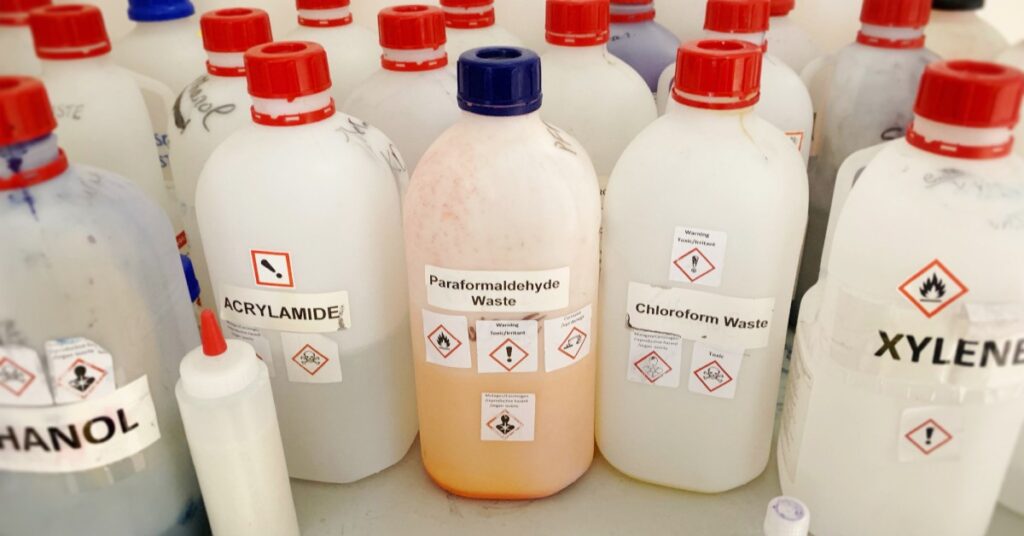Finishing solvents are common in various industries, including woodworking, painting, and automotive. These versatile liquids thin materials, clean surfaces, and seal finishes. Understanding the different types and uses of finishing solvents is essential for achieving the best results in your projects. Explore this quick guide to working with finishing solvents for helpful information.
Types of Finishing Solvents
Finishing solvents serve distinct purposes in various applications. Here’s an overview of some popular solvents.
Acetone
Acetone effectively removes paint, varnish, and adhesives. You see it often in the beauty industry for nail polish removal and in laboratories for cleaning equipment. Acetone evaporates quickly.
This rapid evaporation can be both an advantage and a disadvantage; while it speeds up drying times, it requires you to work quickly to avoid streaks.
Mineral Spirits
Painters and decorators commonly use mineral spirits, also known as white spirits, for thinning oil-based paints and cleaning brushes.
Mineral spirits are easier to handle as they’re less volatile than acetone. However, they have a strong odor and can be harmful if inhaled over long periods.
Denatured Alcohol
Denatured alcohol serves as a versatile solvent for cleaning, degreasing, and thinning shellac. Its rapid evaporation rate makes it ideal for projects requiring quick drying times.
However, denatured alcohol is toxic if you ingest or inhale it in large quantities, so ensure proper ventilation and use protective gear.
Lacquer Thinner
Lacquer thinner, a potent mixture of solvents, dissolves lacquers and varnishes effectively. It works well for cleaning tools and surfaces but can be harsh on the skin and eyes. Additionally, lacquer thinner emits strong fumes, making adequate ventilation essential during use.
Specialty Solvents
- Naphtha cleans and thins oil-based paints. It evaporates quickly and leaves minimal residue.
- Turpentine, derived from pine trees, traditionally thins oil paints and cleans artist brushes. It has a distinctive odor and can cause skin irritation.
- Xylene is a powerful solvent in the automotive and printing industries for cleaning and thinning purposes. Xylene is highly volatile and requires cautious use.

Choosing the Right Solvent for Your Project
Selecting the appropriate finishing solvent involves several vital considerations to ensure optimal results and safety. Start by evaluating material compatibility; different solvents interact uniquely with various surfaces, so choose one that matches your project’s materials.
Consider the desired finish as well. Solvents can significantly influence the final sheen and texture, so think about if you want a matte, glossy, or satin finish.
Drying time is another important factor. Faster-drying solvents might be ideal for quick projects but require more precision to avoid streaks, while slower-drying options allow more working time but may delay project completion.
Never overlook safety and environmental impact. Opt for solvents that pose minimal health risks and have a lower environmental footprint, and always use them in well-ventilated areas with appropriate protective gear.
Here are some specific project examples to guide your choice:
- Mineral spirits are particularly effective for thinning varnishes and cleaning wood surfaces, offering a balance of drying time and ease of use.
- Lacquer thinner is the go-to solvent for dissolving automotive lacquers and cleaning spray guns, providing a smooth, professional finish.
- Denatured alcohol is excellent for thinning shellac and cleaning brushes, ensuring a clean application and quick drying times.
Application Techniques
To thin paints and finishes, add the solvent gradually while stirring continuously. Avoid over-thinning, as this can compromise the quality of the finish. Follow the manufacturer’s recommendations for the correct solvent-to-paint ratio.
Solvents can also seal and protect surfaces. Apply the solvent-based sealant evenly with a brush or spray gun, allowing each coat to dry thoroughly before applying the next. This ensures a smooth, even finish that enhances durability.
Lastly, use solvents to clean brushes, rollers, and other applicators immediately after use. For surfaces, apply the solvent with a clean cloth and wipe away residue and buildup.
Safety Precautions and Handling
Always wear appropriate PPE when working with solvents. This includes gloves, masks, and eye protection to prevent skin contact and inhalation of fumes. As mentioned, working in a well-ventilated area is important when using finishing solvents. Create enough airflow by opening windows and using fans to disperse fumes. If working indoors, consider using a fume extractor. Moreover, store solvents in their original containers, away from heat sources and out of reach of children.
Troubleshooting Common Issues
Inconsistent finishes often result from improper mixing, inadequate surface preparation, or using the wrong solvent. So mix thoroughly and clean the surface properly before applying the finish. Choosing the right solvent for your specific application also helps you achieve a consistent result.
Several factors can affect drying times, including temperature, humidity, and the type of solvent. To expedite drying, increase ventilation in your workspace and opt for a solvent with a faster evaporation rate.
Adverse solvent reactions with materials can cause problems like bubbling, peeling, or discoloration. Always test the solvent on a small, inconspicuous area first to ensure compatibility. If issues persist, switch to a different solvent that better suits the materials you’re working with.
Environmental and Health Considerations
When choosing solvents, consider eco-friendly alternatives that are less harmful to the environment and humans. Options like water-based solvents, biodegradable products, and low-VOC (volatile organic compound) formulations offer safer solutions without compromising performance.
Prolonged exposure to traditional solvents can lead to short-term effects such as headaches, dizziness, and skin irritation. However, long-term issues like respiratory problems and organ damage can also occur. To minimize these risks, follow safety guidelines diligently and use protective gear to ensure a safer working environment.

Solvent Recycling and Waste Management
Solvent recycling and waste management play major roles in promoting sustainability and cost efficiency when working with finishing solvents. Recycling solvents provides environmental and economic benefits by reducing hazardous waste and lowering disposal costs.
For example, acetone recycling systems distill acetone to remove contaminants, allowing reuse. This process reduces waste and saves money for businesses that frequently use acetone.
Additionally, solvent recycling machines reclaim up to 95 percent of solvents, offering features like automated operation, safety controls, and compact designs. These machines make solvent recycling practical for different industries, ensuring businesses can maintain their commitment to environmental responsibility.
Wrap-Up
With this quick guide to working with finishing solvents, you have the essential knowledge to select the right solvent for your project, troubleshoot common issues, and manage solvent recycling and waste effectively. You also understand the importance of environmental and health considerations, ensuring that your work remains safe and sustainable.
By implementing these smart practices, you can achieve professional results and contribute to a more eco-friendly and efficient industry.

